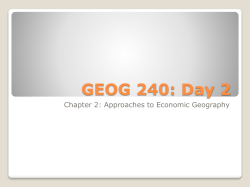
Pre Test Excerpt
SNARC Effect: Approximate Number System and Spatial Representation Ana Martín (anamartin@psico.edu.uy) Center for Basic Research in Psychology, Universidad de la República Tristán Narvaja, 1674. Montevideo, 11200. Uruguay. Sebastián Marichal (sebastian.marichal@seciu.edu.uy) University Computer Service, Universidad de la República Colonia 2066, Montevideo, 11200. Uruguay. Mónica Sánchez (monica.sanchezd@upf.edu) Oksana Pryshchepa (molokolom@gmail.com) Armin Duff (armin.duff@upf.edu) Paul F.M.J Verschure (paul.verschure@upf.edu) Synthetic Perceptive, Emotive and Cognitive Systems group (SPECS), Universidad Pompeu Fabra Roc Boronat, 138, 08018 Barcelona, Spain. Abstract (poster) Relation between numerosity and space is a well known phenomenon that has attracted the interest of many researchers in numerical cognition. SNARC effect, or Spatial Numerical Association of Response Codes, suggest that perception of numbers elicits spatial codes that are associated with the magnitude of the number. It consists on small and large numbers facilitating left/right responses respectively. This effect has been shown during parity judgment number task and magnitude comparison task when numbers or word numbers were employed. Whether this interaction also affects numerosity processing causing lateralized responses in a left to right mental line remains unclear. Here we asked which is the minimum temporal threshold ability to compare numerosities above the rank of subitizing and its interaction with spatial representation. Twenty adults performed a magnitude comparison task of nonsymbolic stimuli where bimanual reactions to a central target were recorded. Two consecutive arrays of dots were presented and participants had to judge if the second array contained more or less dots than the first one. Quantities in each array ranged from 6 to 21 dots and ratios were set into 0.5, 0.6, 0.7 and 0.8. Stimuli presentation varied from 50 ms to 250 ms. Results indicate that numerosity is perceived in a mental number line for longer stimuli’s presentation. However, when shorter durations are introduced response codes seem to influence subject’s response only when difference between stimuli correspond to small ratios. References Bulf, H., de Hevia, M.D., & MacchiCassia, V. (2015). Small on the left, large on the right: Numbers orient preverbal infants’ visual attention onto space. Developmental Science, in press. Cohen, D. J., Warren, E., & BlancGoldhammer, D. (2013). Crossformat physical similarity effects and their implications for the numerical cognition architecture. Cognitive Psychology, 66(4), 355–379. Dehaene, S., Bossini, S., & Giraux, P. (1993). The mental representation of parity and number magnitude. Journal of Experimental Psychology: General 122, 371−396. Dodd, M. D., Van der Stigchel, S., Adil Leghari, M., Fung, G., & Kingstone, A. (2008). Attentional SNARC: there’s something special about numbers (let us count the ways). Cognition, 108(3), 810–8. doi:10.1016/j.cognition.2008.04.006 Feigenson, L., Dehaene, S., & Spelke, E. (2004).Core systems of number. Trends in Cognitive Sciences 8 (7), 307−314. Gebuisa, T., Kenemansa, J.L., de Haanb, E. & van der Smagta, M. (2010). Conflict processing of symbolic and nonsymbolic numerosity. Neuropsychologia 48, 394401. Notebaert, K., Nelis, S., & Reynvoet, B. (2011). The magnitude representation of small and large symbolic numbers in the left and right hemisphere: an eventrelated fMRI study. J. Cogn Neurosci 23(3), (3) 622−630. Patro, K., & Haman, M. (2012). The spatialnumerical congruity effect in preschoolers. Journal of Experimental Child Psychology, 111(3), 534–42. Piazza, M., Pinel, P., Le Bihan, D., & Dehaene, S. (2007). A magnitude code common to numerosities and number symbols in human intraparietal cortex.Neuron 53(2), 293−305. Quarterly, P. S. (2008). On the cognitive link between space and number: a metaanalysis of the SNARC effect, 50(4), 489–525. Ranzini, M., Dehaene, S., Piazza, M., & Hubbard, E. M. (2009). Neural mechanisms of attentional shifts due to irrelevant spatial and numerical cues. Neuropsychologia, 47(12), 2615–24.
© Copyright 2025












